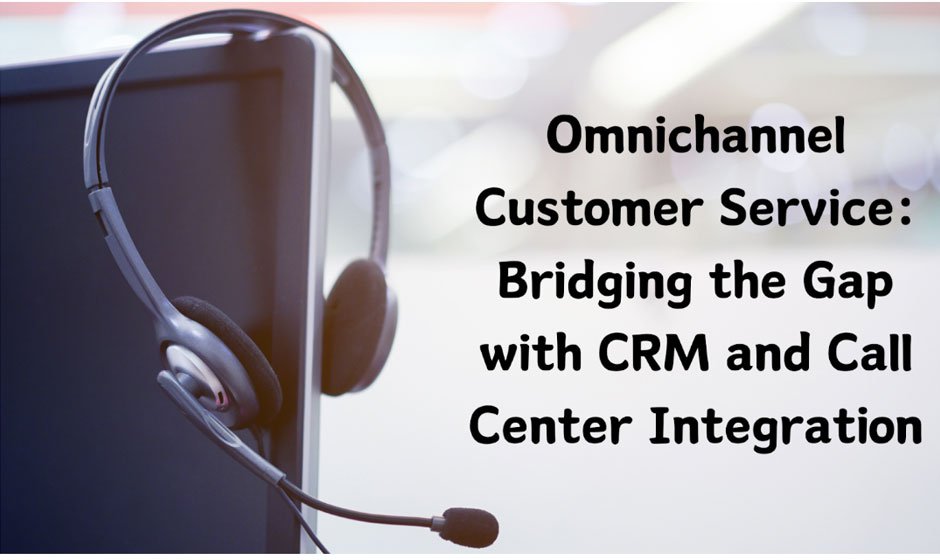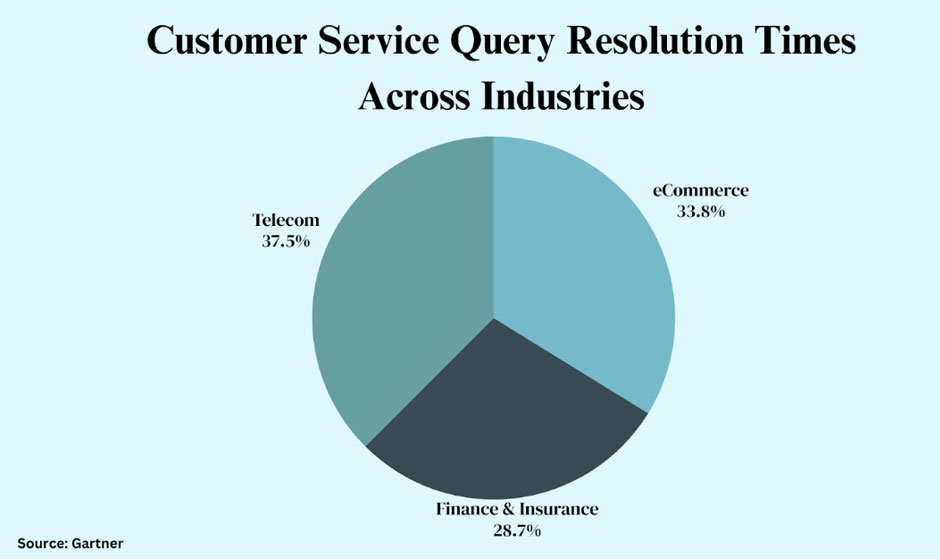Omnichannel Customer Service: Bridging the Gap with CRM and Call Center Integration

The digital age has significantly transformed customer service. Now, more people are shopping online. By 2025, 22.3% of all shopping may happen on the internet. This shows how important CRM is for companies serving customers in many ways. Companies employing CRM as part of their multi-channel customer service strategy retain 89% of their customers. So integrating CRM is very beneficial and essential for success today.
Shift from Multichannel to Omnichannel: Why It Matters
Traditional multichannel strategies, where companies engage customers through isolated touchpoints like phone, email, social media, etc., are no longer sufficient. Customers now expect a seamless experience as they switch between channels, requiring businesses to adopt an omnichannel approach.
An omnichannel strategy integrates all channels into a unified customer journey instead of having disconnected touchpoints. An omnichannel approach results in enhanced efficiency, improved customer retention, and increased revenue. According to LinkedIn, companies with robust omnichannel customer engagement retain an average of 89% of their customers compared to 33% for companies with weak omnichannel capabilities.
Understanding the Digital Customer’s Expectations
Modern digital customers demand convenience, personalization, speed, and flexibility in their interactions. 72% of customers surveyed expect companies to deliver consistent interactions across every channel and touchpoint.
Businesses that fail to understand and cater to these expectations risk losing customers to competitors. Oracle service cloud call center software is the perfect omnichannel strategy, underpinned by actionable customer data, which is crucial for meeting the modern consumer’s needs. This naturally leads us to the role of CRM systems in this landscape.
Integrating CRM with Omnichannel Customer Service
- The integration of CRM with marketing, sales, and service systems facilitates data sharing across channels. This provides complete customer profiles.
- Integrations link call center tools to websites, mobile apps, etc. Agents access the same interfaces as customers, thereby improving support.
- Automated workflows route queries based on past interactions and preferences shown on any channel. Such routing personalizes each customer’s experience.
- Unified data facilitates pattern analysis. Companies can better understand popular channels and service needs of different customer segments.
- The integration enables tracking engagement from the first touchpoint to purchases and beyond. Companies optimize pathways to provide smooth omnichannel journeys.
The Role of CRM in Understanding Customer Journeys
CRM systems help companies gain a unified view of each customer by consolidating data from diverse channels and touchpoints into single records. This provides valuable customer insights that can enhance personalization and improve targeting.
Integrating CRM data into an omnichannel approach helps companies walk a mile in their customers’ shoes. We can trace the winding paths customers take as they move between our website, app, stores, and call center. This insight enables us to craft targeted messages and content that directly address the factors guiding them at each step. Meeting customers where they are keeps them engaged and loving our brand across every channel.
Enhancing Personalization through CRM Data
Personalized communication is a key omnichannel capability. CRM integration supercharges personalization efforts by unlocking robust customer data.
Segmenting customers based on CRM data enables hyper-targeted outreach across channels. For instance, Oracle demonstrated that personalized promotions, triggered by customer behaviors, boosted one retail client’s store revenue by 10%.
Real-time Data Access and its Impact on Customer Service Efficiency
Omnichannel service means sharing customer details instantly between channels. Connecting CRM systems and communication tools allows this. It shares data in real time between marketing, sales, and service.
This ensures agents have immediate access to customer information, regardless of the channel. It allows smooth hand-offs between teams to fix issues quickly. Data shows over 70% of companies that connect systems well can answer customer questions in under 5 minutes. Look at the pie chart below that shows the customer service query resolution times across various industries:

Call Center Transformation with Omnichannel Integration
The transformation of call centers through omnichannel integration is a testament to the power of a unified customer service approach. This transformation highlights the symbiotic relationship between omnichannel service and CRM. Omnichannel customers, who spend 4% more in-store and 10% more online, illustrate the tangible benefits of this integration. CRM systems play a crucial role in capturing and analyzing these interactions, highlighting the interdependence between omnichannel strategies and CRM in creating a comprehensive customer experience.
Bridging the Gap: Traditional Call Centers vs Omnichannel Call Centers
Traditional call centers operate in an isolated manner with little coordination between sales, marketing, and service teams. This fragmented view breeds inefficiencies and inconsistencies across customer interaction channels.
By integrating CRM and omnichannel strategies, call centers transform into information hubs, accessing customer data from all channels and departments. This unified approach breaks down barriers between teams and enables call center agents to facilitate seamless omni-experiences.
Leveraging Technology for Seamless Customer Interactions
Companies invest heavily in call center technology to drive productivity and improve CX. Integrating these systems with CRM and digital channels introduces new capabilities.
AI in contact centers leverages caller data to enhance routing and automation, and predictive analytics empowers agents to better understand and respond to customer needs. Meanwhile, text and web chat facilitate multi-channel conversations between agents and customers, aided by CRM intelligence.
How CRM and Omnichannel Feed into Each Other
CRM data enriches omnichannel personalization, while omnichannel integration expands a CRM system’s capabilities by capturing customer interactions.
This interplay is fundamental to providing exceptional service. CRM intelligence guides effective cross-channel engagement. Meanwhile, comprehensive interaction data from omnichannel systems make CRM records more robust.
Building a Unified View of the Customer
A full understanding of customers is not possible without data from all platforms. Connecting CRM systems and call centers gives a complete view.
Integrating CRM and call centers consolidates data from all channels. It helps divide customers into groups by needs. Agents can then foresee actions. They can craft messages for each customer group. These personalized messages work even if someone switches between platforms.
Strategies for Effective Integration
Linking all software is essential for the easy movement of data in omnichannel customer service. APIs connect the platforms.
Careful step-by-step planning helps combine systems smoothly. The right design makes things simple. For instance, mixing on-site tools with cloud services on a hybrid cloud balances complexity. Utilizing containers also aids in this integration.
At the same time, groups across functions should team up. They need to work together to integrate CRM and omnichannel in a way that fits business needs.
Overcoming Challenges in Integration
While omnichannel service integrated with CRM promises significant benefits, it inevitably also poses challenges stemming from process change and added technological complexity. However, there are ways for companies to anticipate and tackle these hurdles.
Identifying and Addressing Common Pitfalls
Legacy processes and an outdated technology landscape can undermine integration initiatives, restricting data flow and limiting functionality. Other hurdles include internal resistance to change, insufficient collaboration, and lack of executive buy-in.
Proactively avoiding these pitfalls requires thorough planning, stakeholder alignment, upgrades to modern platforms, and leadership commitment to drive adoption.
Best Practices for Smooth Integration
Smooth integration requires meticulous planning considering both business needs and technical constraints. Cross-functional coordination ensures unified objectives across sales, marketing, and service teams, while optimal software architectures and network infrastructure guarantee seamless data flow.
Adequate testing, employee training programs, and incremental rollout also help minimize disruptions that can hinder omnichannel optimization efforts.
Training and Change Management for Staff
When companies take on new systems, workers can feel overloaded and lose interest. This difficulty can impede the transition to integrated platforms.
Ongoing training like workshops and online lessons helps all departments use omnichannel CRM. Regular reminders help inculcate the habit of using these new tools. Surveys give feedback to make the systems better. This way, employees stay engaged in using the new tools.
Measuring Success: KPIs and Metrics for Omnichannel and CRM Integration
Strong execution around strategy, technology, and people lays the foundation for omnichannel success. Quantifiable metrics provide further insight into outcomes. Continuous monitoring and assessment of defined KPIs drive ongoing improvement.
Key Performance Indicators to Watch
Relevant metrics like channel-specific CSAT scores, first-call resolutions, inquiry-to-purchase conversion rates, and omnichannel revenue share indicate overall customer experience uplift and business impact.
Department-specific metrics around query handling time, platform usage across user groups, and multi-channel engagements highlight adoption across teams.
A holistic evaluation of these metrics reveals the interdependencies within omnichannel ecosystems. The analysis then guides future personalization programs, system refinement, and business strategy pivots.
Analyzing Customer Satisfaction and Engagement
While financial indicators provide a clear picture of omnichannel success, customer-centric metrics reveal existing gaps in channel experiences and personalization efforts, guiding enhancements.
Surveys that gather channel-specific CSAT scores and net promoter scores, coupled with analyses of churn and retention, help accurately gauge customer satisfaction. Social media monitoring and call transcription analysis reveal pain points.
Continuous Improvement: Adapting to Customer Feedback and Trends
Companies continually improve their use of integrated CRM and omnichannel contact centers. They check results and watch what customers want.
This means better personalization, predictions, self-service, call routing, and connections. These changes are implemented gradually through system updates.
The Future of Customer Service: Predictions and Trends
Customer service keeps reinventing itself. Customer service is evolving, using the latest technology to engage customers across various channels. Smarter CRM systems enable this.
All the data from different systems makes AI key. It finds and acts on insights to personalize experiences per channel. Recent data indicates a growing preference among some customers for using voice commands and gestures. Enterprises are gearing up for this shift.
FAQs
- How does integrating CRM with an omnichannel approach improve customer service?
Integrating CRM with an omnichannel approach makes customer data available across different platforms. This helps companies personalize messages and improve customer interactions. It can lead to happier customers and more revenue.
- What are the main challenges in integrating call centers with omnichannel strategies, and how can they be overcome?
Old computer systems, employees not wanting change, and no buy-in can make integrating call centers hard. These challenges can be overcome. Modern tools can connect old systems. Leaders can explain the vision and plan the change. Soliciting group input on decisions helps build support. Working together will make the transition smoother.
- How can businesses measure the success of their omnichannel customer service and CRM integration?
Companies can measure success through customer satisfaction surveys, business performance metrics, and monitoring platform use. This gives clear information on what’s working. Checking customer journey experience also shows where more improvements are needed over time.
Conclusion
Combining customer service across all channels with CRM makes a powerful foundation. It helps companies give customers seamless and personalized experiences. This approach is crucial for acquiring new customers, retaining existing ones, and increasing sales.
Innovations will make customer service even more advanced. To stay successful long-term, companies must be ready to adopt new technologies quickly into their customer experience systems. Companies that do not invest to build strong customer experience capabilities now risk disappointing consumers. The opportunity to differentiate before customer expectations evolve further is rapidly diminishing.



